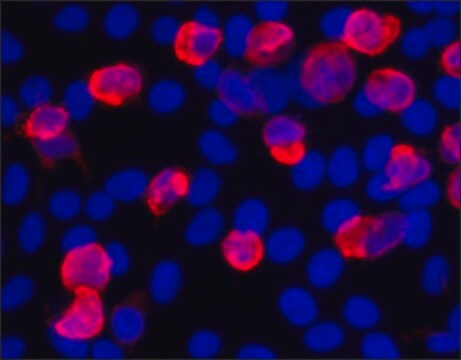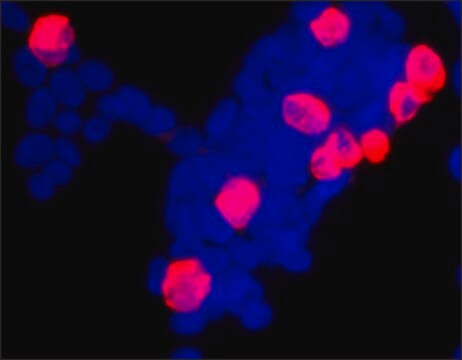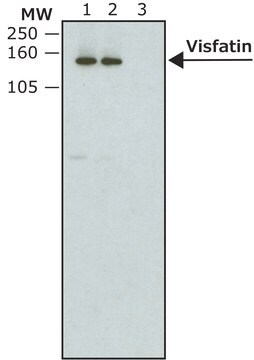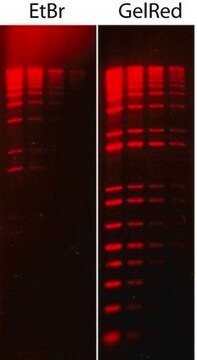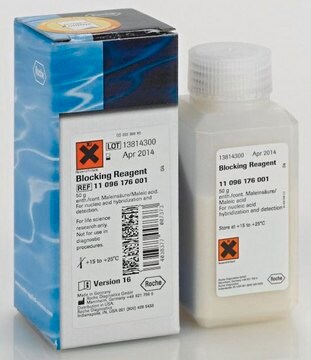V4014
Anti-V5-Cy3™ antibody, Mouse monoclonal
purified immunoglobulin, ~1 mg/mL, clone V5-10
Sinonimo/i:
Monoclonal Anti-V5
Autenticatiper visualizzare i prezzi riservati alla tua organizzazione & contrattuali
About This Item
Prodotti consigliati
Origine biologica
mouse
Livello qualitativo
Coniugato
CY3 conjugate
Forma dell’anticorpo
purified immunoglobulin
Tipo di anticorpo
primary antibodies
Clone
V5-10, monoclonal
Concentrazione
~1 mg/mL
tecniche
immunocytochemistry: 2.0-4.0 μg/mL
Condizioni di spedizione
wet ice
Temperatura di conservazione
2-8°C
Cerchi prodotti simili? Visita Guida al confronto tra prodotti
Descrizione generale
Monoclonal Anti-V5 (mouse IgG1 isotype) is derived from the V5 hybridoma, produced by fusion of mouse myeloma cells and splenocytes from BALB/c mice immunized with a synthetic peptide corresponding to amino acid residues GKPIPNPLLGLDST (95-108) of the P/V proteins of the Paramyxovirus SV5, conjugated to KLH. The conjugate is then extensively dialyzed to remove unbound Cy3 fluorophore. Monoclonal Anti-V5, Cy3 conjugate recognizes the V5 tag sequence on V5 tagged fusion proteins by immunocytochemistry.
Specificità
Recognizes V5 Tag (GKPIPNPLLGLDST) fusion proteins
Applicazioni
Many recombinant proteins have been engineered to express a short sequence derived from the V5 molecule known as V5-tag. This tag facilitates the detection, isolation and purification of the proteins. Monoclonal antibodies reacting specifically with V5 and conjugated to Cy3 may be useful in various immunotechniques, and also to identify the expression of a V5 tagged fusion protein in situ by immunofluorescence.
Stato fisico
Solution in 0.01 M phosphate buffered saline, pH 7.4, containing 1% bovine serum albumin and 15 mM sodium azide.
Note legali
Cy3 is a trademark of Cytiva
Non trovi il prodotto giusto?
Prova il nostro Motore di ricerca dei prodotti.
Codice della classe di stoccaggio
10 - Combustible liquids
Classe di pericolosità dell'acqua (WGK)
WGK 2
Punto d’infiammabilità (°F)
Not applicable
Punto d’infiammabilità (°C)
Not applicable
Scegli una delle versioni più recenti:
Possiedi già questo prodotto?
I documenti relativi ai prodotti acquistati recentemente sono disponibili nell’Archivio dei documenti.
Dharmendra K Singh et al.
Molecular plant-microbe interactions : MPMI, 27(1), 7-17 (2013-09-21)
Protein kinase-driven phosphorylation constitutes the core of cellular signaling. Kinase components of signal transduction pathways are often targeted for inactivation by pathogens. The study of kinases and immune signal transduction in the model crop tomato (Solanum lycopersicum) would benefit from
C Dunn et al.
Journal of immunological methods, 224(1-2), 141-150 (1999-06-05)
The monoclonal antibody (mAb) SV5-Pk is used widely in a variety of procedures to detect recombinant proteins tagged with the Pk tag, a 14 amino acid sequence derived from the P and V proteins of the paramyxovirus Simian Virus 5.
J A Southern et al.
The Journal of general virology, 72 ( Pt 7), 1551-1557 (1991-07-01)
Two canine isolates of simian virus 5 (SV5), termed CPI+ and CPI-, were examined for their ability to react with a bank of monoclonal antibodies (MAbs) that had been previously raised against a human isolate of SV5. CPI- virus was
S M Thomas et al.
Cell, 54(6), 891-902 (1988-09-09)
The "P" gene of the paramyxovirus SV5 encodes two known proteins, P (Mr approximately equal to 44,000) and V (Mr approximately equal to 24,000). The complete nucleotide sequence of the "P" gene has been obtained and is found to contain
Suena Ji et al.
Nature communications, 9(1), 3508-3508 (2018-08-31)
Regulated secretion is an essential process where molecules destined for export are directed to membranous secretory granules, where they undergo packaging and maturation. Here, we identify a gene (pgant9) that influences the structure and shape of secretory granules within the
Il team dei nostri ricercatori vanta grande esperienza in tutte le aree della ricerca quali Life Science, scienza dei materiali, sintesi chimica, cromatografia, discipline analitiche, ecc..
Contatta l'Assistenza Tecnica.